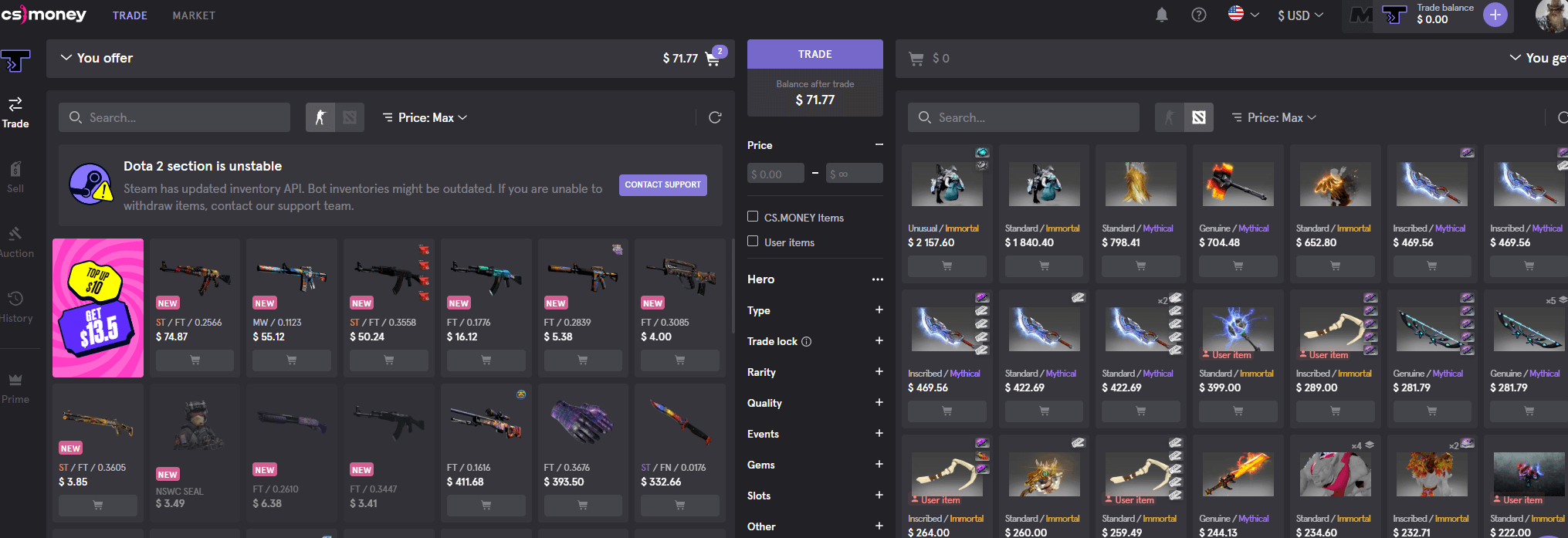CGKY News Hub
Your go-to source for the latest insights and trends.
The Skin Exchange: Where Dota 2 Meets The Stock Market
Discover how Dota 2 skins are revolutionizing virtual trading! Join The Skin Exchange and explore the thrilling market of digital collectibles.
Understanding Dota 2 Skin Valuation: How Rarity and Demand Impact Prices
In the world of Dota 2 skins, understanding how rarity and demand affect prices is crucial for players and collectors alike. The valuation of skins is largely influenced by their scarcity; limited edition skins or those that are no longer obtainable often command higher prices due to their exclusivity. For instance, skins categorized as Immortal or Ancient typically have a much higher market value compared to common skins. A thorough grasp of the different rarity tiers, such as Common, Uncommon, Rare, and Mythical, can help players make informed decisions while trading or purchasing skins.
Additionally, demand plays a significant role in the fluctuating prices of Dota 2 skins. The popularity of specific heroes, ongoing events, or metas can drive up demand for certain skins, leading to price increases. Market trends often reveal that skins associated with popular heroes or those featured in high-profile tournaments tend to see a surge in interest. It's essential for players to stay updated with the current game meta and community discussions to understand which skins are likely to rise in value. Ultimately, by analyzing both rarity and demand, players can effectively navigate the Dota 2 skin marketplace.

The Economics of Dota 2: Is Trading Skins Like Investing in Stocks?
The economics of Dota 2 revolves significantly around the trading of in-game skins, leading many to draw parallels between this practice and investing in stocks. Just like the stock market, the value of skins fluctuates based on various factors, including rarity, demand, and community trends. Players often engage in extensive market research, analyzing past price movements and current market conditions to make informed decisions about their trades. This behavior mirrors that of seasoned investors who study stock performances and market dynamics before buying or selling their assets.
Furthermore, the Dota 2 skin market features its own set of unique risks and rewards. While some players have turned significant profits by speculating on skin values, others have faced losses similar to those encountered in traditional investments. Factors such as limited-time promotions and updates can drastically alter the desirability and price of skins overnight. As a result, understanding market sentiment and staying updated on game developments become crucial for players looking to treat their skin collections as a form of investment. Thus, the intricate balance of supply, demand, and volatility within this digital economy echoes the essence of stock trading.
Maximizing Your Dota 2 Skin Portfolio: Tips for New Traders
Maximizing your Dota 2 skin portfolio is crucial for new traders looking to enhance their gaming experience and potential profits. Begin by understanding the market dynamics of Dota 2 skins, including supply, demand, and rarity factors. Utilizing marketplaces like the Steam Community Market, third-party sites, and trading forums will give you insights into price fluctuations. To build a diverse and valuable skin collection, focus on including a mix of common, rare, and exclusive skins that appeal to various player bases. This strategy not only increases your chances of successful trades but also makes your portfolio more appealing for potential buyers in the future.
Another important tip for maximizing your Dota 2 skin portfolio is to stay informed about trends and updates within the game. Keeping track of patch notes, hero updates, and major esports events can influence skin values dramatically. For instance, when a certain hero receives significant buffs, related skins may experience a spike in value. Additionally, consider joining communities or forums where you can share experiences and gain insights from veteran traders. By participating actively, you can learn the nuances of trading and investing in skins, ensuring that your portfolio remains relevant and potentially profitable in this ever-evolving market.